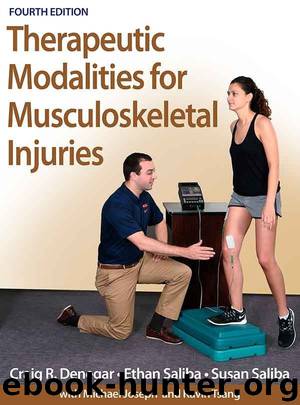Therapeutic Modalities for Musculoskeletal Injuries, 4E by Craig R. Denegar & Ethan Saliba & Susan Saliba

Author:Craig R. Denegar & Ethan Saliba & Susan Saliba [Denegar, Craig R.]
Language: eng
Format: mobi
ISBN: 9781492507437
Publisher: Human Kinetics
Published: 2015-11-24T05:00:00+00:00
Impact on Blood Flow
Localized cooling creates a number of physiological responses, including decreased blood flow in the skin. The skin is the largest thermoregulatory organ and is capable of mediating temperature changes by controlling its vascularity. When the skin is cooled, superficial vasoconstriction occurs primarily through reflex mechanisms as arteriole sphincters are directly stimulated by the cold. In addition, a decrease in local histamine and prostaglandin (vasodilators) contributes to vasoconstriction. Fluid viscosity (thickness of a liquid) also is increased, resulting in less blood flowing in the local area. Maximum decrease in local blood flow is reported to occur at approximately 57°F (13.9°C). A point to keep in mind for later discussion is that constriction or decrease in the diameter of lymphatic vessels occurs at approximately 59°F (15°C).
Changes in blood flow through deeper tissues occurs due to decreased metabolic activity. Perfusion is decreased at rest and increased during exercise. Various researchers have examined whether a local application of ice affects muscle perfusion, and recent evidence shows that blood flow in a skeletal muscle is not changed with cryotherapy (Selkow et al. 2012). Therefore, ice may have a positive effect on pain and other factors, but it would not limit the delivery of oxygen to the tissues. Hypothetically, if a large area is cooled as with whole body cooling or cold submersion, there may be deeper vascular changes. As cooling lowers the metabolic activity and oxygen demand of local cells, less blood flow is routed to the area.
The cold-induced effects of vasoconstriction, increased fluid viscosity, and decreased blood flow must be examined within the context of the injury environment. For example, the combined effects of vasoconstriction and increased fluid viscosity may be of significance in response to an acute injury involving blood loss. However, these same effects may not be important when treating a musculoskeletal injury, as blood loss has already been managed by the actions of the clotting cascade. In contrast, cooling may slow neutrophil migration acutely and reduce lymphatic drainage as the acute inflammatory response subsides.
Download
This site does not store any files on its server. We only index and link to content provided by other sites. Please contact the content providers to delete copyright contents if any and email us, we'll remove relevant links or contents immediately.
Unwinding Anxiety by Judson Brewer(70140)
The Art of Coaching by Elena Aguilar(49977)
The Fast Metabolism Diet Cookbook by Haylie Pomroy(20483)
Rewire Your Anxious Brain by Catherine M. Pittman(17580)
Healthy Aging For Dummies by Brent Agin & Sharon Perkins RN(16606)
Talking to Strangers by Malcolm Gladwell(11859)
The Art of Thinking Clearly by Rolf Dobelli(8836)
Crazy Rich Asians by Kevin Kwan(8340)
Mindhunter: Inside the FBI's Elite Serial Crime Unit by John E. Douglas & Mark Olshaker(7827)
The Compound Effect by Darren Hardy(7545)
Crystal Healing for Women by Mariah K. Lyons(7372)
Therapeutic Modalities for Musculoskeletal Injuries, 4E by Craig R. Denegar & Ethan Saliba & Susan Saliba(7344)
Periodization Training for Sports by Tudor Bompa(7322)
Bodyweight Strength Training by Jay Cardiello(7180)
Becoming Supernatural by Dr. Joe Dispenza(7099)
Wonder by R. J. Palacio(7049)
Tools of Titans by Timothy Ferriss(6934)
Should I Stay or Should I Go? by Ramani Durvasula(6779)
How to Be a Bawse: A Guide to Conquering Life by Lilly Singh(6686)
